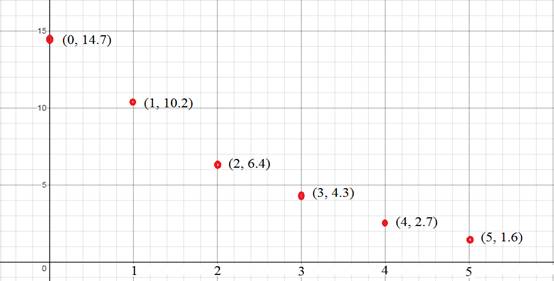
Concept explainers
(a)
Write a set of ordered pairs for the data.
(a)
Answer to Problem 42CCR
Ordered Pair: (0, 14.7), (1, 10.2), (2, 6.4), (3, 4.3), (4, 2.7), (5, 1.6)
Explanation of Solution
Given:
The air pressure decreases as the distance from Earth increases. The table shows the air pressure for certain distances.
Air Pressure
| Height(mile) | Pressure(lb/ sq inch) |
| 0 (sea level) | 14.7 |
| 1 | 10.2 |
| 2 | 6.4 |
| 3 | 4.3 |
| 4 | 2.7 |
| 5 | 1.6 |
Concept Used:
Write a set of ordered pairs for the data.
Ordered pair we can write in this way: (height, Pressure)
Calculation:
Ordered Pair: (0, 14.7), (1, 10.2), (2, 6.4), (3, 4.3), (4, 2.7), (5, 1.6)
Thus, Ordered Pair: (0, 14.7), (1, 10.2), (2, 6.4), (3, 4.3), (4, 2.7), (5, 1.6)
(b)
Graph the data
(b)
Answer to Problem 42CCR
Explanation of Solution
Given:
The air pressure decreases as the distance from Earth increases. The table shows the air pressure for certain distances.
Air Pressure
| Height(mile) | Pressure(lb/ sq inch) |
| 0 (sea level) | 14.7 |
| 1 | 10.2 |
| 2 | 6.4 |
| 3 | 4.3 |
| 4 | 2.7 |
| 5 | 1.6 |
Concept Used:
Graph the data
Calculation:
Graph:

Thus,
(c)
Find the relationship a proportional relationship.
(c)
Answer to Problem 42CCR
No, the relationship is not proportional
Explanation of Solution
Given:
The air pressure decreases as the distance from Earth increases. The table shows the air pressure for certain distances.
Air Pressure
| Height(mile) | Pressure(lb/ sq inch) |
| 0 (sea level) | 14.7 |
| 1 | 10.2 |
| 2 | 6.4 |
| 3 | 4.3 |
| 4 | 2.7 |
| 5 | 1.6 |
Is the relationship a proportional relationship? Why or why not?
Concept Used:
No, the relationship is not proportional, neither the differences are equal nor their ratios are equal.
Thus, no, the relationship is not proportional.
Chapter 8 Solutions
Glencoe Math Accelerated, Student Edition
Additional Math Textbook Solutions
Calculus: Early Transcendentals (2nd Edition)
Algebra and Trigonometry (6th Edition)
A First Course in Probability (10th Edition)
Elementary Statistics: Picturing the World (7th Edition)
Introductory Statistics
Elementary Statistics (13th Edition)
- 1. A bicyclist is riding their bike along the Chicago Lakefront Trail. The velocity (in feet per second) of the bicyclist is recorded below. Use (a) Simpson's Rule, and (b) the Trapezoidal Rule to estimate the total distance the bicyclist traveled during the 8-second period. t 0 2 4 6 8 V 10 15 12 10 16 2. Find the midpoint rule approximation for (a) n = 4 +5 x²dx using n subintervals. 1° 2 (b) n = 8 36 32 28 36 32 28 24 24 20 20 16 16 12 8- 4 1 2 3 4 5 6 12 8 4 1 2 3 4 5 6arrow_forward= 5 37 A 4 8 0.5 06 9arrow_forwardConsider the following system of equations, Ax=b : x+2y+3z - w = 2 2x4z2w = 3 -x+6y+17z7w = 0 -9x-2y+13z7w = -14 a. Find the solution to the system. Write it as a parametric equation. You can use a computer to do the row reduction. b. What is a geometric description of the solution? Explain how you know. c. Write the solution in vector form? d. What is the solution to the homogeneous system, Ax=0?arrow_forward
- 2. Find a matrix A with the following qualities a. A is 3 x 3. b. The matrix A is not lower triangular and is not upper triangular. c. At least one value in each row is not a 1, 2,-1, -2, or 0 d. A is invertible.arrow_forwardFind the exact area inside r=2sin(2\theta ) and outside r=\sqrt(3)arrow_forwardA 20 foot ladder rests on level ground; its head (top) is against a vertical wall. The bottom of the ladder begins by being 12 feet from the wall but begins moving away at the rate of 0.1 feet per second. At what rate is the top of the ladder slipping down the wall? You may use a calculator.arrow_forward
- Explain the key points and reasons for the establishment of 12.3.2(integral Test)arrow_forwardUse 12.4.2 to determine whether the infinite series on the right side of equation 12.6.5, 12.6.6 and 12.6.7 converges for every real number x.arrow_forwarduse Cauchy Mean-Value Theorem to derive Corollary 12.6.2, and then derive 12.6.3arrow_forward
 Calculus: Early TranscendentalsCalculusISBN:9781285741550Author:James StewartPublisher:Cengage Learning
Calculus: Early TranscendentalsCalculusISBN:9781285741550Author:James StewartPublisher:Cengage Learning Thomas' Calculus (14th Edition)CalculusISBN:9780134438986Author:Joel R. Hass, Christopher E. Heil, Maurice D. WeirPublisher:PEARSON
Thomas' Calculus (14th Edition)CalculusISBN:9780134438986Author:Joel R. Hass, Christopher E. Heil, Maurice D. WeirPublisher:PEARSON Calculus: Early Transcendentals (3rd Edition)CalculusISBN:9780134763644Author:William L. Briggs, Lyle Cochran, Bernard Gillett, Eric SchulzPublisher:PEARSON
Calculus: Early Transcendentals (3rd Edition)CalculusISBN:9780134763644Author:William L. Briggs, Lyle Cochran, Bernard Gillett, Eric SchulzPublisher:PEARSON Calculus: Early TranscendentalsCalculusISBN:9781319050740Author:Jon Rogawski, Colin Adams, Robert FranzosaPublisher:W. H. Freeman
Calculus: Early TranscendentalsCalculusISBN:9781319050740Author:Jon Rogawski, Colin Adams, Robert FranzosaPublisher:W. H. Freeman
 Calculus: Early Transcendental FunctionsCalculusISBN:9781337552516Author:Ron Larson, Bruce H. EdwardsPublisher:Cengage Learning
Calculus: Early Transcendental FunctionsCalculusISBN:9781337552516Author:Ron Larson, Bruce H. EdwardsPublisher:Cengage Learning





